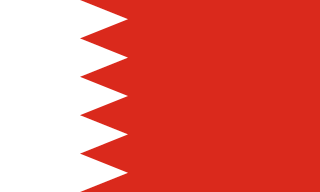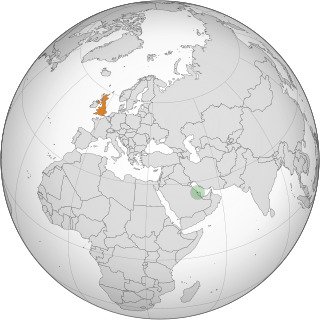Related Research Articles

Manama is the capital and largest city of Bahrain, with an approximate population of 200,000 people as of 2020. Long an important trading center in the Persian Gulf, Manama is home to a very diverse population. After periods of Portuguese and Persian control and invasions from the ruling dynasties of Saudi Arabia and Oman, Bahrain established itself as an independent nation in 1971 after a period of British hegemony.
Bahrain was a central location of the ancient Dilmun civilization. Bahrain's strategic location in the Persian Gulf has brought rule and influence from mostly the Persians, Sumerians, Assyrians, Babylonians, Portuguese, the Arabs, and the British.

The Kingdom of Bahrain consists of Bahrain Island and 33 of the p37 Bahrain Islands, lying in the Persian Gulf's Gulf of Bahrain off the north shore of Asia's Arabian Peninsula. Bahrain's capital city is Manama. The islands are about 24 kilometers (15 mi) off the east coast of Saudi Arabia and 28 kilometers (17 mi) from Qatar. The total area of the country is about 694 square kilometers (268 sq mi), about four times the size of the District of Columbia.

Zubarah, also referred to as Al Zubarah or Az Zubarah, is a ruined and ancient fort located on the north western coast of the Qatar peninsula in the Al Shamal municipality, about 105 km from the Qatari capital of Doha. It was founded by Shaikh Muhammed bin Khalifa, the founder father of Al Khalifa royal family of Bahrain, the main and principal Utub tribe in the first half of the eighteenth century. It was designated a UNESCO World Heritage Site in 2013.
Sir Charles Dalrymple Belgrave KBE was a British citizen and advisor to the rulers of Bahrain from 1926 until 1957, as "Chief Administrator" or "adviserate". He first served under Shaikh Hamad ibn Isa Al Khalifa (1872–1942), and subsequently under Shaikh Salman ibn Hamad Al-Khalifa (1895–1961).

Hamad ibn Isa Al Khalifa KCIE, CSI was the Hakim (ruler) of Bahrain from the death of his father, Hakim Isa ibn Ali, on 9 December 1932 until his own death in 1942.

Bahraini Jews constitute one of the world's smallest Jewish communities, although its origins go back to late antiquity. Talmudic sources refer to ports and islands on the Persian Gulf, indicating that Jews may have already settled in this region. Arabic sources record Jews in the old capital of Bahrain, Hajar, at the time of the Islamic conquest in 630 C.E. In the 12th century, the Jewish traveler-adventurer Benjamin of Tudela mentions 500 Jews living in Qays, and 5,000 in Al-Qatîf, involved in pearl fishery. In the 19th century, there were Jewish merchants from Iraq, Persia, and India in Bahrain.

Bilad al-Qadeem is a suburb of Manama in Bahrain.

The Ajam of Bahrain, also known as Persians of Bahrain or Iranians of Bahrain, are an ethnic group in Bahrain composed of Shia Bahraini citizens of Persian/Iranian background.

Bahrain, officially the Kingdom of Bahrain, is a country in the Persian Gulf. The island nation comprises a small archipelago made up of 50 natural islands and an additional 33 artificial islands, centered on Bahrain Island which makes up around 83 percent of the country's landmass. The country is situated between the Qatari peninsula and the north eastern coast of Saudi Arabia to which it is connected by the 25-kilometre (16 mi) King Fahd Causeway. According to the 2020 census, Bahrain's population numbers 1,501,635 people, of which 712,362 are Bahraini nationals. At 760 square kilometres (290 sq mi) in size, it is the third-smallest nation in Asia after the Maldives and Singapore. The capital and largest city is Manama.

Bilateral relations exist between Kingdom of Bahrain and the United Kingdom of Great Britain and Northern Ireland. Bahrain has an embassy in London and the United Kingdom is one of only four European countries to maintain an embassy in Manama. Bahrain gained independence from the United Kingdom in 1971 and has since maintained strong diplomatic, military and trade relations.
Nelida Fuccaro, Ph.D., is a historian and professor of modern Middle Eastern history at the New York University Abu Dhabi.

Fareej Mushbir is an old district neighbouring the Manama Souq, in the city of Manama, Bahrain. The district was part of the original core of Old Manama, prior to its expansion in the 20th century.

The following is a timeline of the Bahraini uprising from February to March 2011, beginning with the start of protests in February 2011 and including the Saudi and Emirati-backed crackdown from 15 March.

The Islamic month of Muharram is a period of mourning in Shia Islam and commemorates the death of Imam Hussain, the third Imam, and his companions at the Battle of Karbala in 680 AD. Processions called Azadari are held to commemorate and remember the events that took place, these are often organised by congregation halls known as Hussainia. Mourning climaxes on the tenth day of Muharram, Ashura. The mourning is sometimes referred to as the Remembrance of Muharram.
The administrative reforms of the 1920s were a series of British-led reforms that have laid the foundations of modern Bahrain. They took place between 1919 and 1927, but their background extends to the early 19th century. Britain signed a number of treaties with Bahrain in 1820, 1861, 1880 and 1892. The latter two had effectively turned Bahrain into a British Protectorate. Earlier in 1869, Britain had appointed the young Shaikh Isa ibn Ali Al Khalifa as ruler. Shaikh Isa was an autocrat and a feudal overlord whose authority was shared with his family and Sunni tribal allies. The economy was dependent on pearl diving and palm farming. Both sectors suffered from great inequalities; the conditions of the mostly Baharnah (Shia) peasants and the mostly non-Bahraini divers were often compared to slaves. Since the beginning of the 20th century, the British influence in Bahrain has been on the rise; in 1904-5 they extended their jurisdiction over all foreigners and in 1913 issued an Order in Council, which effectively turned Bahrain into a colony. The Order was not implemented until after the end of World War I.

The American Mission Hospital is a private not-for-profit hospital located in Manama, Bahrain.
Sawt al-Bahrain was a monthly political magazine published in Manama, Bahrain, between 1950 and 1954. It was the first independent publication by the Bahraini intellectuals. The magazine laid the basis for the High Executive Committee which was a cross-sectarian nationalist political movement in Bahrain founded in 1955 and inspired other publications including al-Isha which was a cultural journal.
Al Qafilah was a weekly newspaper published in Manama, Bahrain, between 1952 and 1956.

Yusuf bin Ahmed Kanoo, also known as Haji Yusuf, was a Bahraini merchant and trader who, in 1890, took over his father's business and started the trading empire that would grow into the Yusuf bin Ahmed Kanoo Group, one of the largest independent trading companies in the Gulf region.
References
- 1 2 3 Fuccaro, Nelida (2009). Histories of City and State in the Persian Gulf: Manama Since 1800. New York: Cambridge University Press. p. 102. ISBN 9781107404441 . Retrieved 8 June 2021.
- 1 2 East India Company, the Board of Control, the India Office, or other British Government Department. "File 2/2 Victoria Memorial Hospital Establishment - Ruling and Correspondence with Higher Authorities". Qatar National Library. The India Office. Retrieved 8 June 2021.CS1 maint: multiple names: authors list (link)
- ↑ Al Hilli, F. "History of Medical Laboratory Services in Bahrain. Part 1. The Beginning and Early Developments (1940-1963)" (PDF). Bahrain Medical Bulletin - Vol.24, No. 4, December 2002. Retrieved 8 June 2021.
- 1 2 Lowe, Daniel. "The Death of Queen Victoria: the Politics of Mourning and Memorialisation in the British Persian Gulf". Asian and African studies blog. The British Library. Retrieved 13 June 2021.
- 1 2 3 4 Saldanha, Jerome A. (1986). The Persian Gulf Précis - Volume IV: Bahrein Affairs - Katar Affairs. United Kingdom: Cambridge Archive Editions. p. 126. ISBN 978-1-85207-000-7.
- ↑ "Roots of True Island Love". Gulf Weekly. Al Hilal Publishing Company. 20 July 2011. Retrieved 8 June 2011.
- ↑ Stapley, Karen. "The' unprecedented' case of John Calcott Gaskin". British Library. British Library. Retrieved 1 November 2021.
- ↑ Tuson, Penelope (2003). Playing the game : Western women in Arabia. London: I.B. Tauris - Bloomsbury. ISBN 9781860649332.
- ↑ "Treasure Minute Dated 21 March 1957 Concerning a Gift of Land in Bahrein". Antiquariat INLIBRIS Gilhofer Nfg. London: Her Majesty's Stationery Office. 21 March 1957. Retrieved 9 June 2021.